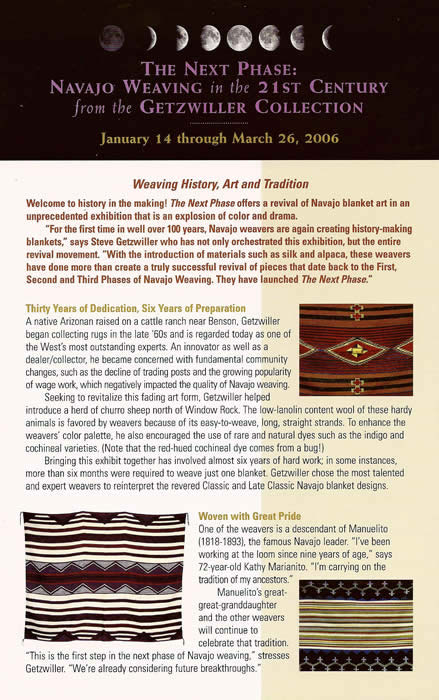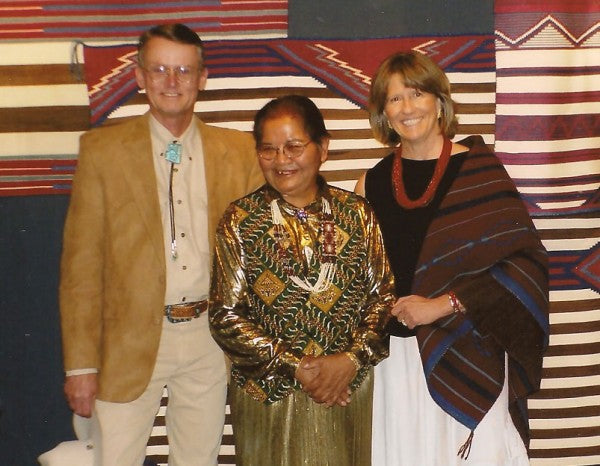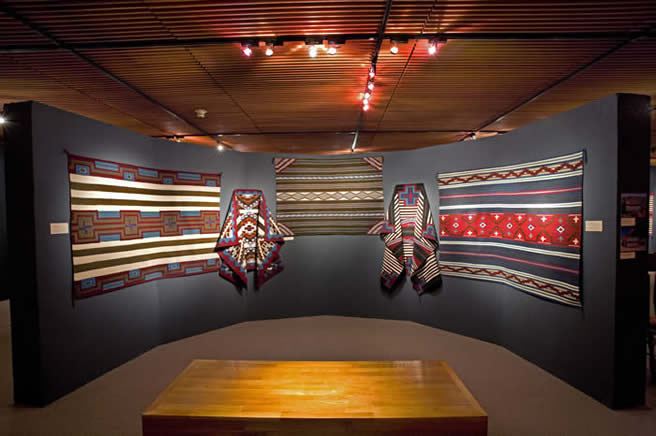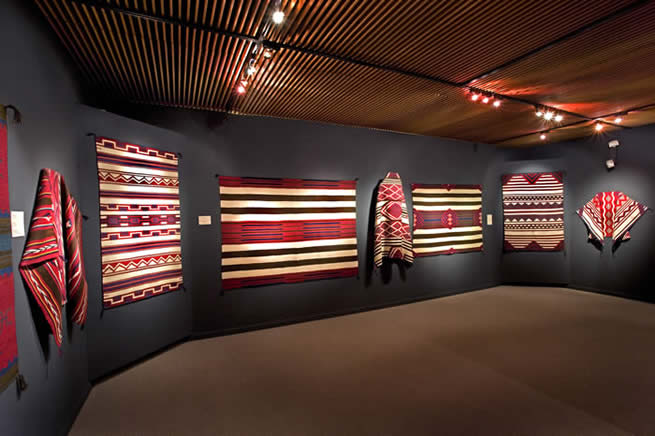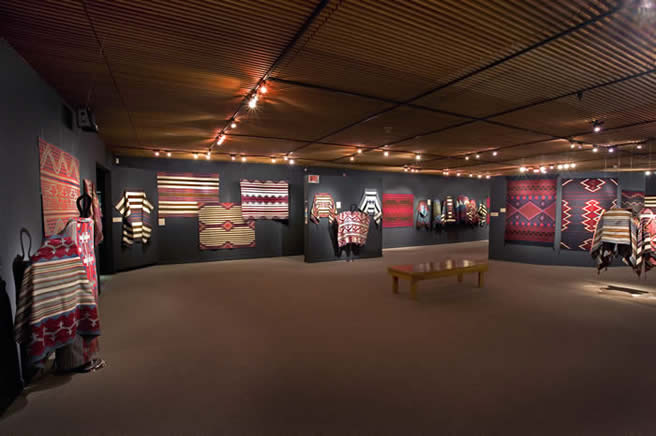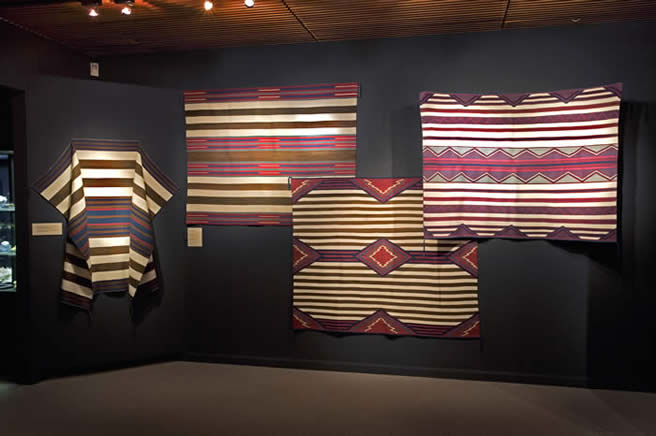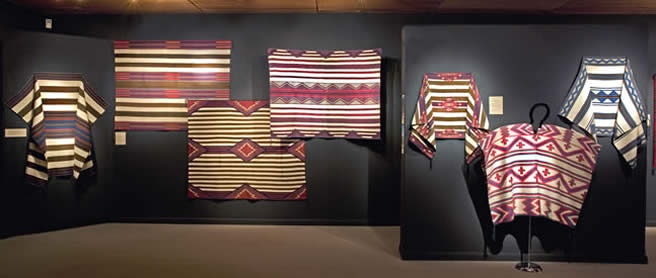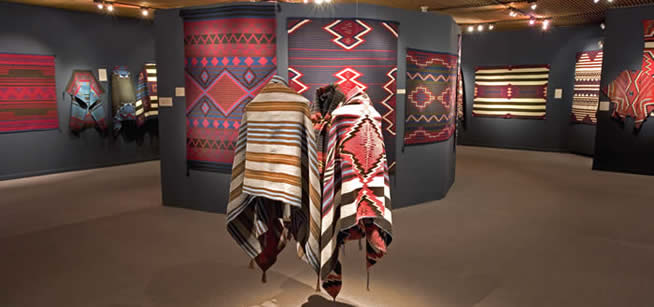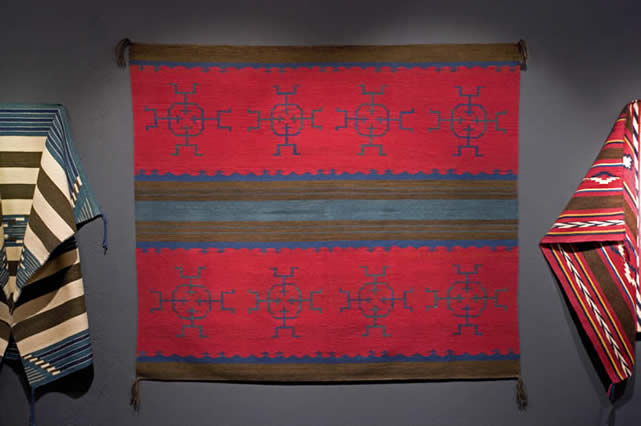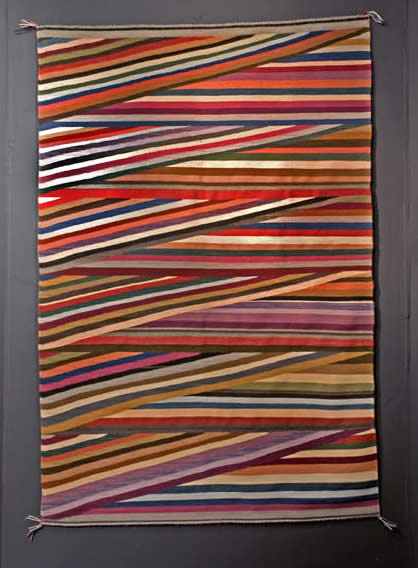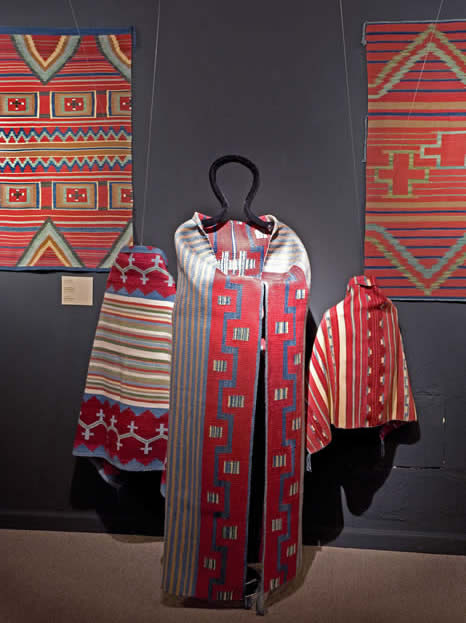Exhibit: 2006 - The Next Phase
NAVAJO WEAVING IN THE 21ST CENTURY FROM THE GETZWILLER COLLECTION
This exhibit was truly history in the making! The Next Phase offered a revival of woven Navajo blankets "actually Navajo Blankets". for the first time, in well over 100 years! Opening day also featuring Kathy Marianito, the grand dame of the Navajo Chief Blanket, demonstrating her techniques, weaving a Chief Blanket on the loom.
The entire exhibit featured Navajo Blankets woven in the style of the Classic Blankets, an accomplishment never achieved before. The Getzwiller's commissioned and documented each blanket. The majority of them were woven by one extended family, the Marianito's.
It took 6 years to assemble this extensive grouping of blankets. The weavers sometimes taking over 6 months to complete one blanket. Natural dyes familiar in the history of Navajo Blankets were used; i.e. Indigo, cochineal, and other vegetal dye stuff gathered on the Navajo Reservation. Fibers used were Churro wool, and for the first time silk and alpaca were introduced. The fine and supple blankets exhibited were as fine, if not finer, than any historic Navajo Blanket ever woven.
The original intent of this exhibit was to show contemporary examples of Navajo Wearing Blankets and variations on the theme, to demonstrate how the Wearing Blanket might have evolved had the Trading Post Era not intervened.
Weaving History, Art and Tradition
Welcome to history in the making! The Next Phase offers a revival of Navajo blanket art in an unprecedented exhibition that is an explosion of color and drama.
"For the first time in well over 100 years, Navajo weavers are again creating history-making blankets." says Steve Getzwiller who has not only orchestrated this exhibition, but the entire revival movement. "With the introduction of materials such as silk and alpaca, these weavers have done more than create a truly successful revival of pieces that date back to the 1st, 2nd and 3rd Phases of Navajo Weaving. They have launched The Next Phase."
Thirty Years of Dedication, Six Years of Preparation
A native Arizonan raised on a cattle ranch near Benson, Getzwiller began collecting rugs in the late 1960s and is regarded today as one of the West's most outstanding experts. An innovator as well as a dealer/collector, he became concerned with fundamental community changes, such as the decline of trading posts and the growing popularity of wage work, which negatively impacted the quality of Navajo weaving.
Seeking to revitalize this fading art form, Getzwiller helped introduce a herd of Churro sheep north of Window Rock. The low-lanolin content wool of these hardy animals is favored by weavers because of its easy-to-weave, long, straight strands. To enhance the weavers' color palette, he also encouraged the use of rare and natural dyes such as the indigo and cochineal varieties. (Note that the red-hued cochineal dye comes from a bug!)
Bringing this exhibit together has involved almost six years of hard work; in some instances, more than six months was required to weave just one blanket. Getzwiller chose the most talented and expert weavers to reinterpret the revered Classic and Late Classic Navajo blanket designs.
Woven with Great Pride
One of the weavers is a descendant of Manuelito (1818-1893), the famous Navajo leader. "I've been working at the loom since nine years of age," says 72-year-old Kathy Marianito. "I'm carrying on the tradition of my ancestors."
Manuelito's great-great-granddaughter and the other weavers will continue to celebrate that tradition. "This is the first step in the next phase of Navajo weaving," stresses Getzwiller, "We're already considering the future breakthroughs."
Blankets Vis-a-Vis Rugs: Navajo Weaving Comes Full Circle.
In the beginning, Navajo weaving focused on blankets made to be worn. Distinguished by bands which connect when wrapped around the wearer, these early weavings are extremely rare today, and valuable.
When the Santa Fe Trail opened in the 1840s, new materials appeared; for instance, red-hued cloth from Europe was eagerly sought after. Navajo weavers unraveled the threads and interwove them with strands of Churro wool. Made primarily for trading purposes, these blanket could command as much as $40-$60 in gold or many horses.
Unfortunately, when manufactured blankets were introduced in the late 1800s by companies such as Pendleton, the indigenous market suffered a severe blow. As a result, the new century witnessed the advent of the Navajo rug, and its subsequent popularity in the nations's homes. (Gustav Stickley, a leader of the American Arts and Crafts Movement, favored these rugs.)
Accustomed to weaving rugs, The Next Phase weavers had to become familiar with the differences involved in creating blankets. "Navajo blankets are not woven the same as rugs and the differences are immense. The weight of rug wool is much heavier, for example," says Getzwiller. "To illustrate the differences in designs, I provided the artists with examples of period weavings."
Getzwiller also provided the weavers with new materials such as silk and alpaca with have never been utilized in Navajo blankets.
An analogy can be drawn between the use of these new materials and the red-hued European cloth that was introduced to the Navajo weaving more than 150 years ago. "History is repeating itself," Getzwiller says.
